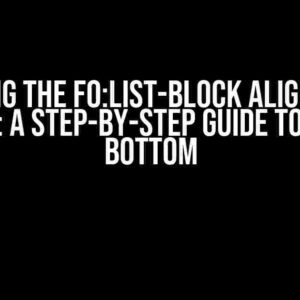Welcome to the frustrating world of Chart.js gotchas! You’ve spent hours crafting the perfect line chart, only to notice a pesky 1px gap between the background fill and the canvas edge. Don’t worry, friend, you’re not alone. This phenomenon has puzzled many a developer, and today, we’re going to put an end to it once and for all.
What’s causing the gap?
Before we dive into the solution, let’s understand why this gap is occurring in the first place. The culprit behind this phenomenon is the way Chart.js handles the canvas edges. By default, Chart.js applies a 1px border around the canvas, which is meant to provide a slight buffer between the chart and the surrounding container. This border is usually invisible, but it can cause issues when you’re trying to create a seamless design.
The role of chartArea and scales
In a Chart.js line chart, the chartArea object defines the area where the chart is drawn. This area is typically smaller than the canvas itself, leaving a small margin around the edges. The scales (x-axis and y-axis) are then drawn within this chart area, with their edges aligned to the chart area’s edges.
chartArea: {
backgroundColor: 'rgba(0, 255, 0, 0.5)'
},
scales: {
x: {
display: true,
grid: {
drawBorder: true
}
},
y: {
display: true,
grid: {
drawBorder: true
}
}
}In this example, the chart area has a green background fill, which should, in theory, extend all the way to the canvas edges. However, due to the aforementioned 1px border, a gap appears between the fill and the canvas edge.
Solutions: Bridging the gap
Now that we understand the cause, let’s explore three solutions to get rid of that pesky gap:
Solution 1: Remove the border
The most straightforward approach is to remove the border altogether. You can do this by setting the borderWidth property to 0 in your chart options:
options: {
layout: {
padding: 0
},
scales: {
x: {
display: true,
grid: {
drawBorder: true,
borderWidth: 0
}
},
y: {
display: true,
grid: {
drawBorder: true,
borderWidth: 0
}
}
}
}This solution works, but keep in mind that it might affect the overall design and layout of your chart.
Solution 2: Adjust the chartArea padding
Alternatively, you can adjust the chartArea.padding property to compensate for the border. By setting a negative padding value, you can effectively “pull” the chart area towards the canvas edge:
chartArea: {
backgroundColor: 'rgba(0, 255, 0, 0.5)',
padding: -1
}This approach is more targeted, as it only affects the chart area, leaving the scales and other elements untouched.
Solution 3: Use a custom plugin
For a more elegant solution, you can create a custom Chart.js plugin that removes the border or adjusts the padding programmatically. Here’s an example plugin:
const removeBorderPlugin = {
id: 'removeBorder',
beforeLayout: (chart) => {
chart.chartArea.borderWidth = 0;
}
};Register the plugin with your chart:
new Chart('myChart', {
// ...
plugins: [removeBorderPlugin]
});This approach provides more flexibility, as you can customize the plugin to fit your specific requirements.
Putting it all together
Let’s see how these solutions come together in a real-world example. Here’s the updated code with the custom plugin:
<canvas id="myChart"></canvas>
<script>
const ctx = document.getElementById('myChart').getContext('2d');
const removeBorderPlugin = {
id: 'removeBorder',
beforeLayout: (chart) => {
chart.chartArea.borderWidth = 0;
}
};
new Chart(ctx, {
type: 'line',
data: {
labels: ['Jan', 'Feb', 'Mar', 'Apr', 'May'],
datasets: [{
label: 'Line Chart',
data: [10, 20, 30, 40, 50],
backgroundColor: 'rgba(0, 255, 0, 0.5)',
borderColor: 'rgba(0, 0, 0, 1)',
pointStyle: 'line'
}]
},
options: {
plugins: [removeBorderPlugin],
layout: {
padding: 0
},
scales: {
x: {
display: true,
grid: {
drawBorder: true
}
},
y: {
display: true,
grid: {
drawBorder: true
}
}
}
});
</script>The resulting chart should now have a seamless background fill that extends all the way to the canvas edges.
Conclusion
The 1px gap between the background fill and the canvas edge in a Chart.js line chart can be frustrating, but with these solutions, you’re equipped to tackle the issue head-on. Whether you choose to remove the border, adjust the chartArea padding, or create a custom plugin, you’ll be able to achieve a visually appealing and gap-free design.
Remember, when working with Chart.js, it’s essential to understand the underlying architecture and behavior of the library. By doing so, you’ll be better equipped to overcome common hurdles and create stunning, data-driven visualizations.
| Solution | Pros | Cons |
|---|---|---|
| Remove border | Simple and effective | May affect overall design and layout |
| Adjust chartArea padding | Targeted solution, doesn’t affect scales | Requires negative padding value |
| Custom plugin | Flexible and customizable | Requires additional code and registration |
Now, go forth and conquer the world of Chart.js line charts, gap-free and proud!
Frequently Asked Question
Get ready to uncover the mystery behind the pesky 1px gap in your Chart.js line chart!
Why does the 1px gap exist in the first place?
The 1px gap is likely due to the chart’s default border settings. By default, Chart.js adds a 1px border around the canvas to prevent the chart from bleeding beyond its boundaries. This border can cause a 1px gap between the background fill and the canvas edge. Fear not, for we have solutions to tackle this pesky gap!
Can I simply remove the border to eliminate the gap?
You’re on the right track! Yes, you can remove the border by setting the `borderWidth` option to 0. However, be cautious, as this might lead to chart elements bleeding beyond the canvas boundaries. A better approach is to set the `borderWidth` to 0 and then use a custom solution to maintain the chart’s boundaries.
Is there a way to move the background fill to the edge of the canvas?
You bet! You can use the `rtl` (right-to-left) option and set it to `true`. This will move the background fill to the edge of the canvas, effectively eliminating the 1px gap. Just be aware that this might affect the chart’s overall layout and design.
Can I use CSS to tackle the 1px gap issue?
CSS to the rescue! Yes, you can use CSS to override the default border settings and eliminate the 1px gap. Simply add a CSS rule to set the border-width to 0 or use a negative margin to move the background fill to the edge of the canvas. Just be sure to target the correct chart element with your CSS selector.
Are there any plugins or workarounds available to solve this issue?
You’re in luck! There are plugins and workarounds available to help you tackle the 1px gap. For example, you can use the `chartjs-plugin-annotation` plugin, which provides a built-in solution for removing the gap. Alternatively, you can explore custom workarounds shared by the Chart.js community.


